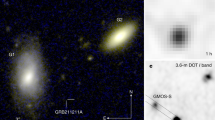Abstract
ALTHOUGH cosmic rays of energies up to 1020 eV have been detected, their origin remains obscure. Supernova remnants, pulsars and accreting binary systems containing neutron stars have been suggested as sources, but the link between these sites and cosmic rays cannot be directly established because interstellar magnetic fields render the distribution of charged particles spatially homogeneous. The discovery1 of γ-rays of PeV (1015 eV) energy from Cygnus X-3, an X-ray binary, lends credibility to these sites as cosmic-ray sources, because γ-rays of such energy could only be produced by the interaction of very-high-energy particles with ambient matter. Systematic searches at TeV and PeV energies have revealed a few other possible sources, but the mostly sporadic nature of these detections has led to some doubt over their reality. Here we report the simultaneous detection on 23 February 1989, by experiments in the Kolar Gold Fields in southern India and the Baksan Valley of the northern Caucasus mountains in the USSR, of a PeV burst from the Crab Nebula, an object long suspected of being a cosmic-ray source.
This is a preview of subscription content, access via your institution
Access options
Subscribe to this journal
Receive 51 print issues and online access
$199.00 per year
only $3.90 per issue
Buy this article
- Purchase on Springer Link
- Instant access to full article PDF
Prices may be subject to local taxes which are calculated during checkout
Similar content being viewed by others
References
Samorski, M. & Stamm, W. Astrophys. J. 268, L17–L20 (1983).
Alexeenko, V. V. et al. Proc. Int. Workshop on Very High Energy Gamma Ray Astronomy (eds Stepanian, A. A. Fegan, D. J. & Cawley, M. F.) 187–191 (1989).
Bhat, P. N. et al. Techniques in Ultra High Energy Gamma Ray Astronomy (eds Protheroe, R. J. & Stephens, S. A.) 1–7 (University of Adelaide, Adelaide, 1985).
Bhat, P. N. et al. Very High Energy Gamma Ray Astronomy (ed. Turver, K. E.) 271–274 (Reidel, Dordrecht, 1987).
Acharya, B. S. et al. Cosmic Gamma Rays. Neutrinos and Related Astrophysics (eds Shapiro, M. M. & Wefel, J. P.) 235–243 (Kluwer, Dordrecht, 1989).
Sinha, S. et al. Proc. 21 Int. Conf. Cosmic Rays Vol. 4 (ed. Protheroe, R. J.) 334–337 (University of Adelaide, Adelaide, 1990).
Li, T. P. & Ma, Y. Q. Astrophysics J. 272, 317–324 (1983).
Frodesen, A. G., Skjeggestad, O. & Tofte, H. Probability and Statistics In Particle Physics (Universitetsforlaget, Bergen, 1979).
Ochs, W. & Stodolsky, L. Phys. Rev. D33, 1247–1251 (1986).
Drees, M. & Halzen, F. Phys. Rev. Lett. 61, 275–277 (1988).
Domokos, G. & Kovesi-Domokos, S. Phys. Rev. D38, 2833–2840 (1988).
Yodh, G. B. Physics and Astrophysics of Quark-Gluon Plasma (eds Sinha, B. & Raha, S.) 230–246 (World Scientific, Singapore, 1988).
Author information
Authors and Affiliations
Rights and permissions
About this article
Cite this article
Acharya, B., Rao, M., Sivaprasad, K. et al. First simultaneous detection of PeV energy burst from the Crab Nebula. Nature 347, 364–365 (1990). https://doi.org/10.1038/347364a0
Received:
Published:
Issue Date:
DOI: https://doi.org/10.1038/347364a0
This article is cited by
-
VHE gamma-ray observation of Crab Nebula with HAGAR telescope array
Experimental Astronomy (2019)
-
New astronomies with Extensive Air Showers
Il Nuovo Cimento C (1995)
-
EAS-TOP: Results of the gamma-ray astronomy at 1014 eV
Il Nuovo Cimento C (1992)
Comments
By submitting a comment you agree to abide by our Terms and Community Guidelines. If you find something abusive or that does not comply with our terms or guidelines please flag it as inappropriate.



